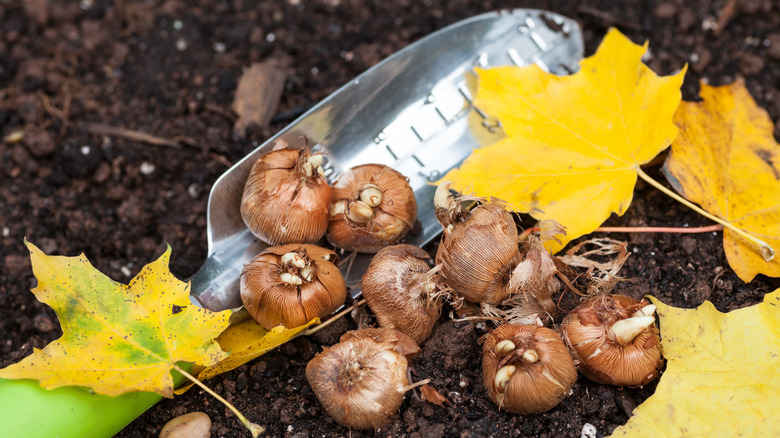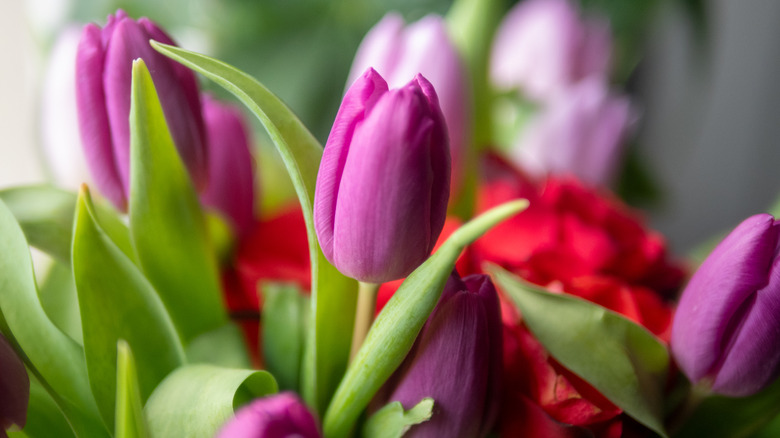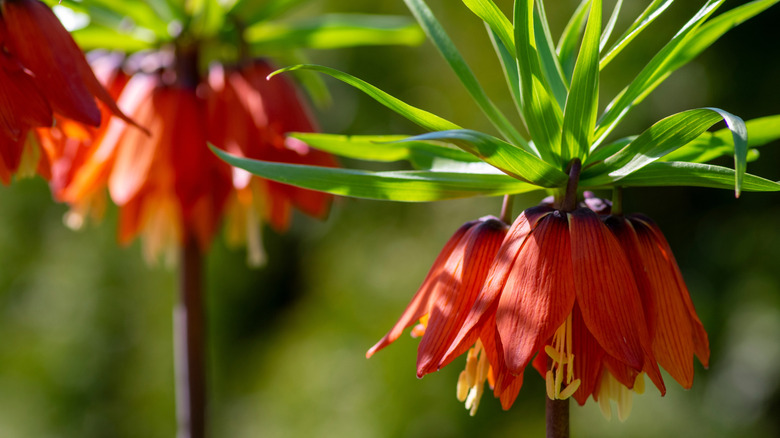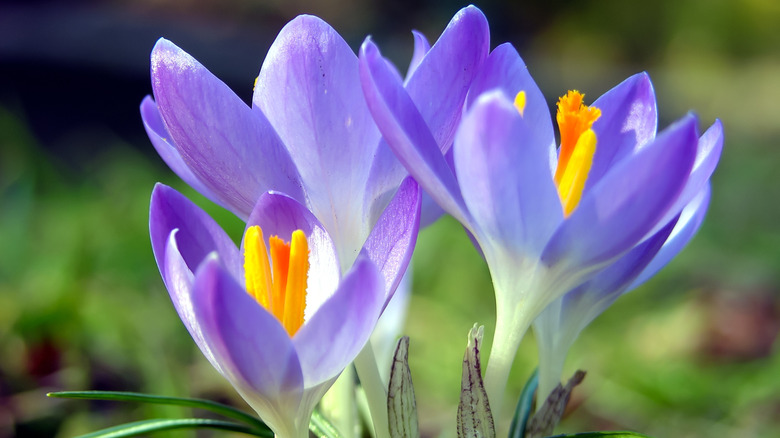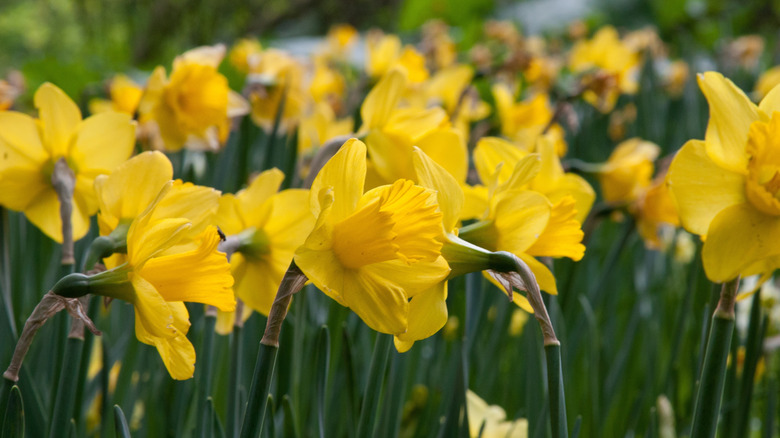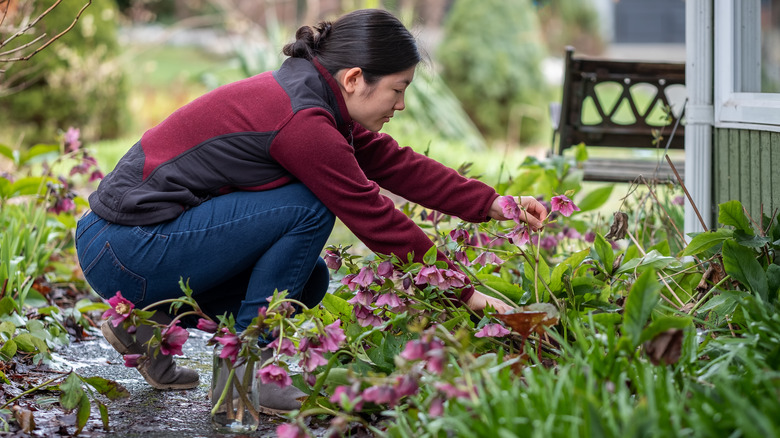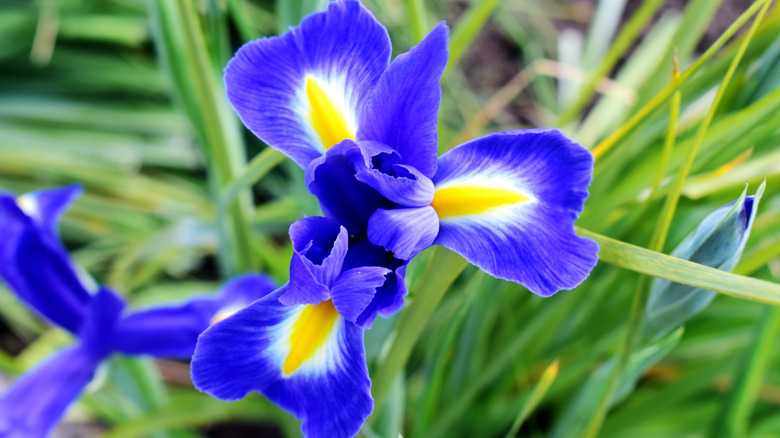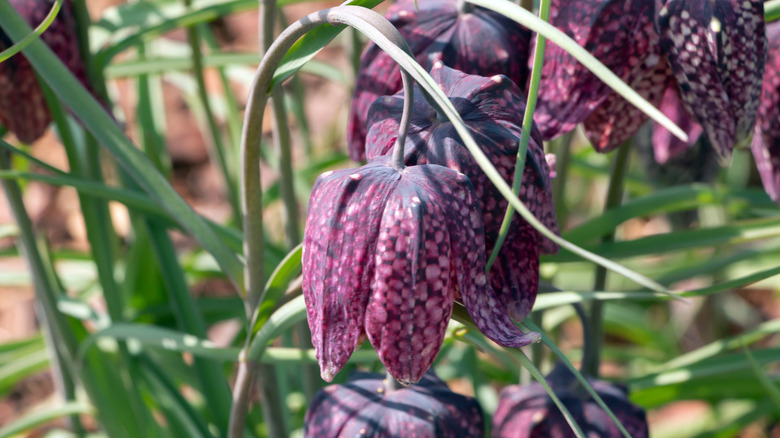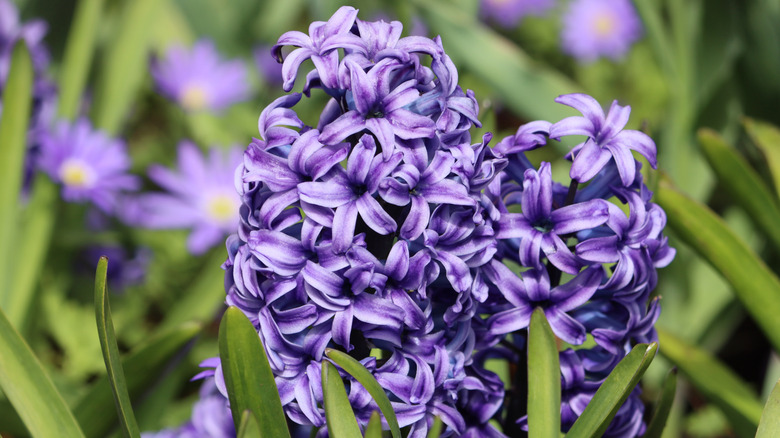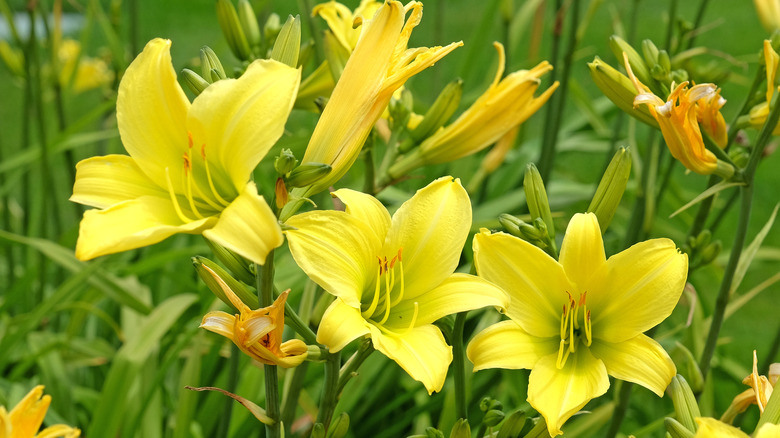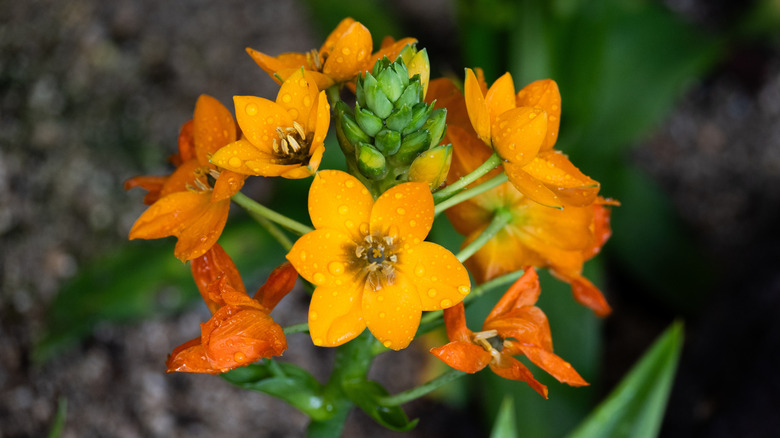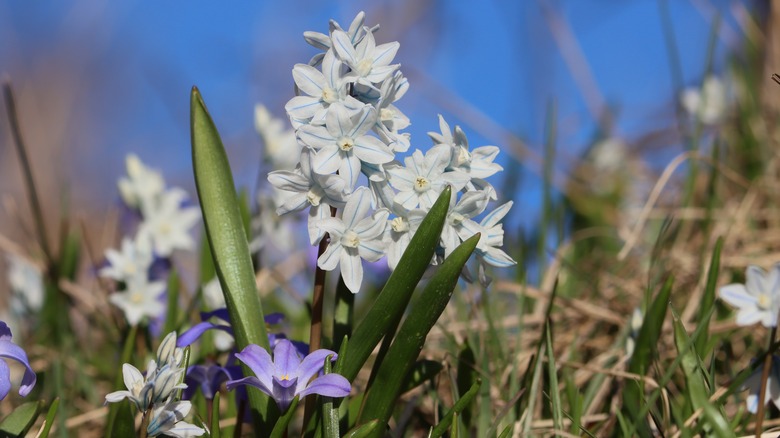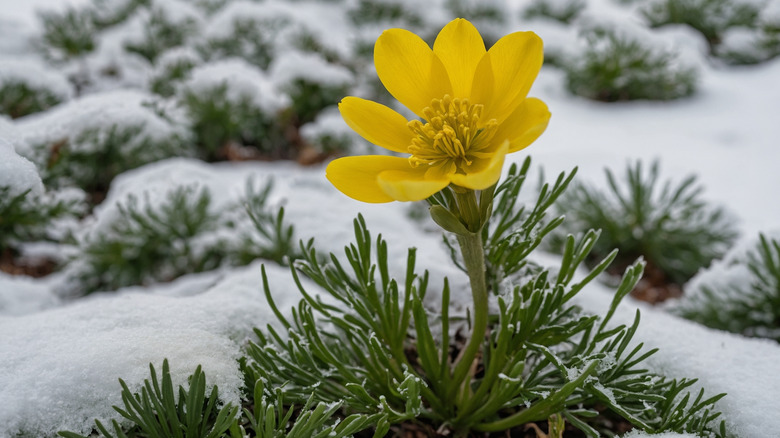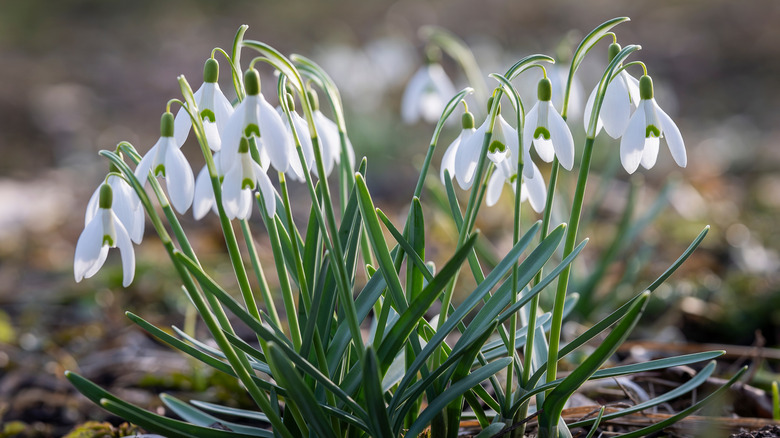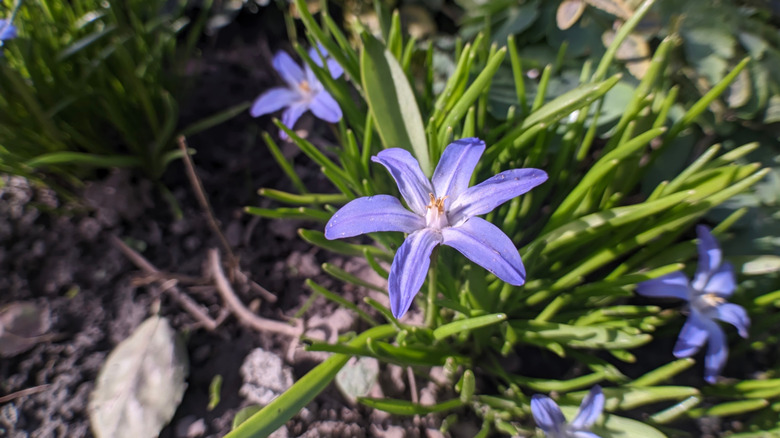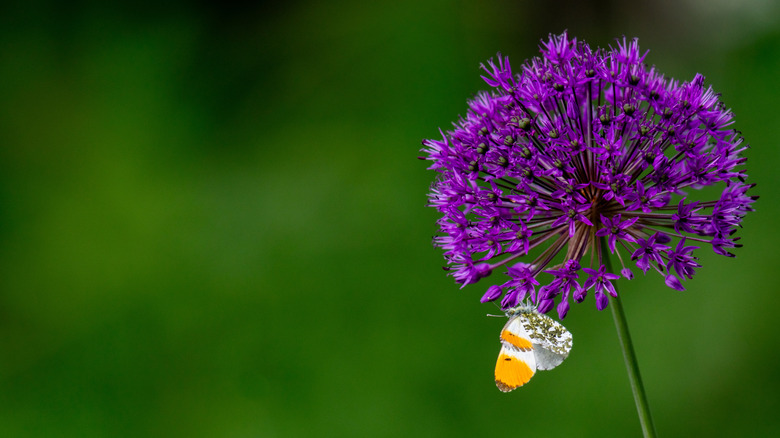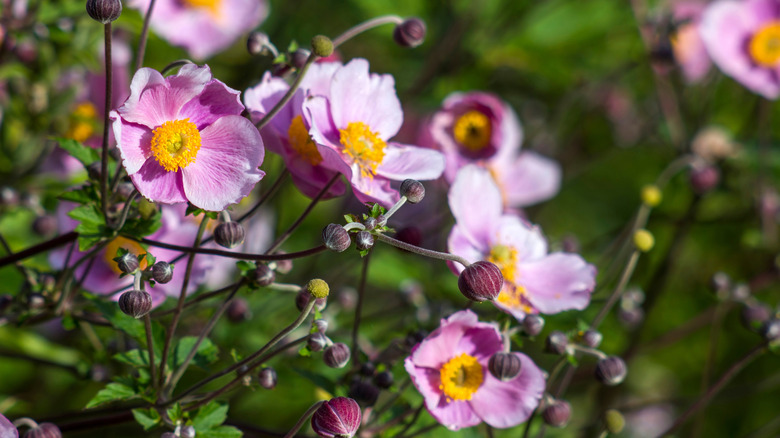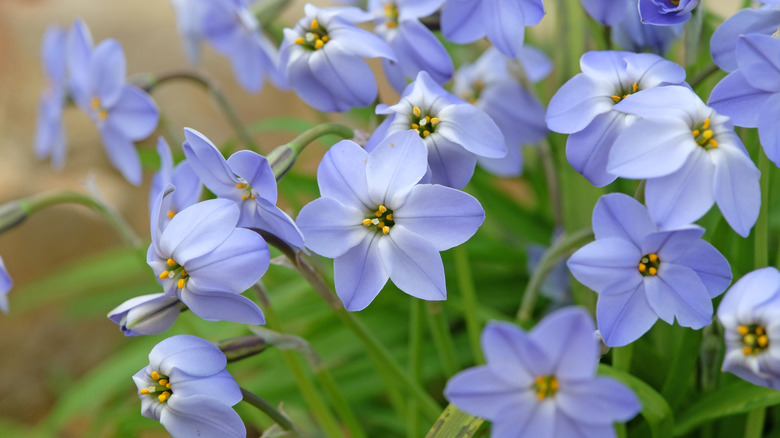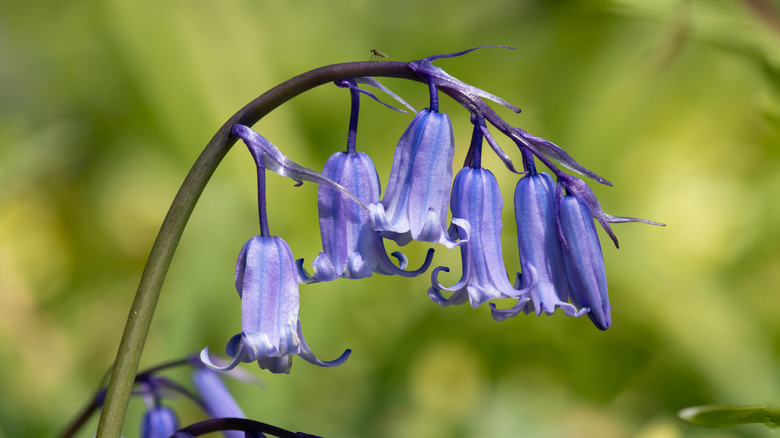18 Bulbs To Plant In The Fall For A Stunning Spring Garden
Before the frost hits and the ground gets hard, plant bulbs in your garden for amazing blooms come spring. Fall might just be the perfect time to prepare for the next crop of tulips, lilies, daffodils, or bluebells. That's because many bulbs need a cold period before they bloom. Tulips and daffodils require a cold spell of temperatures below 40 degrees for a few months before they can sprout. If you wait until spring to plant bulbs, then they won't get the chilly dormant period they need, and there's a very good chance they will not grow flowers when the weather warms. You'll have to wait another full year before you see any colorful petals.
When buying bulbs, look for healthy ones that feel firm, not mushy, to the touch. A good rule of thumb to live by is dig holes three times bigger than the bulbs themselves to plant them as well. For best results, plant your spring-blooming bulbs in the fall when the thermometer outside hits the 50s – typically in middle or late fall for many regions of the U.S. Give the bulbs a month and a half (or so) before steady frost and freezing weather settles in. They need some time to grow roots and establish themselves before they feel the full wrath of winter.
At the end of the day, we're all looking ahead to warmer weather and the promise of a beautiful springtime garden emerging after winter. Flowering bulbs are the ideal option for you to plant now, in autumn. For more garden inspiration, here are 18 bulbs to plant this autumn for amazing blooms in the spring.
Plant tulip bulbs in the fall for amazing blooms in the spring
It's not really spring until the tulips poke up from the cold ground, often giving your garden the first little peek of color after a long winter. Tulips don't mind the cold — they tolerate USDA Plant Hardiness Zones 3 to 8. Plant tulips when temperatures drop steadily to 50 degrees. A good strategy is to put a few bulbs together in the same hole so when they emerge from the ground they'll be bunched together, like a ready-made bouquet. Give them about an inch of space apart.
Crown imperials may help discourage voles next spring
For a unique blooming bulb in your yard, try the crown imperial (Fritillaria imperialis). This pretty flower, with its unusual downward-facing cluster of petals topped with a green crown of leaves, will grow in sun or partial shade, and thrives in zones 5 to 9. When planting crown imperial in the fall, making sure to bury the bulbs deep in the soil, 10 inches below the surface. Bonus, crown imperials might also be among flowers that voles hate because they have a distinctive smell and their bulbs are poisonous to them.
Plant crocus now to attract pollinators in the spring
Pollinators like bees and butterflies love the sweet crocus flower — so much so that this early spring bloomer might even wake hibernating bees with the strong smell of their sweet pollen. While bees love crocuses, deer and rabbits usually don't, so they might leave these pretty flowers alone. When planting crocus corms in the fall, aim for a sunny spot because they like at least six hours of sun a day. Give them a well-draining part of the garden, too. Crocus does best in zones 5 through 9.
Cooler temperatures help daffodils grow roots in the fall
For easy bulbs to plant, don't forget sunny yellow daffodils (Narcissus spp.). They prefer to be planted in sunny or a mostly sunny spots, usually in mid to late fall, when weather is cooler but not yet freezing. You might not know that daffodils actually come in other colors as well, including pink, white, and orange. Hardy in zones 3 to 8, daffodils might also be a good thing to plant in your garden if you've got a groundhog problem. The rodents tend to avoid daffodil bulbs and flowers.
Avoid summer heat by planting hellebore in the fall
While you can plant hellebore in the summer, heat can stress out the plant, so you're better off waiting until the fall. Hellebore (Helleborus spp.) also known as lenten rose, prefers the milder winters of zones 5 through 8. If you live in that region, autumn is a great time to plant hellebore bulbs. This flower isn't needy. Just be sure to water weekly after planting. If you want an early bloomer, try the Heleborus niger — also called Christmas rose, since it blooms around that time.
Dutch iris bulbs will grow pretty spring flowers
Gardeners love dramatic blooms, so this autumn add the Dutch iris (Iris hollandica) to your garden. This is a hybrid plant, not born in nature but created from breeding irises. Gardeners love this large flower that bears a passing resemblance to an orchid. Also, it tends to last longer than other cut flowers for indoor bouquets. Remember that the Dutch iris prefers milder winter zones 6 to 9. When choosing bulbs, go for larger ones, which will likely grow stronger plants.
Checkered fritillary might repel squirrels
If you want to plant a perennial flower that could help keep squirrels away, try checkered fritillary (Fritillaria meleagris), the hanging bell flower that squirrels don't seem to like. A relative of the crown imperial, checkered fritillary adds an interesting pattern to any garden. This flower grows well in zones 3 to 8. When planting checkered fritillary, aim for no more than 16 bulbs per square foot of soil. In the spring, you can expect flowers to grow about a foot or so tall.
For pretty hyacinth in spring, plant in autumn
Common hyacinth (Hyacinthus orientalis) loves to be planted in anytime in the fall. You want to get the bulbs in the ground before the first hard freeze in your region. Once established, hyacinths don't mind the cold, and thrive in zones as low as 4. If you plant now, you can look to see purple, pink, white, or blue blooms come April. Their statuesque tall clusters of petals do well in garden borders as long as there's plenty of sunlight.
Plant no-fuss daylilies in the spring or fall
The copious bloomer, the daylily (Hemerocallis spp.), grows almost anywhere with minimum effort. You can plant this hardy perennial in the spring or fall, and in most parts of the U.S. If it had its pick, though, it would choose zones 4 through 9. Plant daylilies in a sunny spot, away from big shrubs or trees, so it can spread out and not fight other roots for water. If you've already got a whole bunch of daylilies, then fall might be the perfect time to divide and replant them.
Orange star bulbs thrive with fall planting
Another great bulb to plant in autumn might be the orange star plant (Ornithogalum dubium). Its pretty star-shaped clusters of orange flowers will perk up any garden. Perfect for milder climates like zones 7 through 11, orange stars also work in small backyards, since they usually grow shorter than a foot. Just plant this cheerful flower in a place with at least 6 hours of sun a day. This pest-resistant flower is such a stunner that it won the Award of Garden Merit from the Royal Horticultural Society.
Plant early bloomer striped squill in the fall
You may not know about striped squill (Puschkinia scilloides) with its white cluster of flowers named for the stripes it sports down the middle of its star-shaped petals. Known for blooming as early as late winter, striped squill loves to grow in zones 4 to 8. It's related to asparagus, and fun fact: It's so robust, it can manage to thrive even under a black walnut tree. You can plant striped squill in spring or fall. Just give each bulb a few inches of space between them.
Prepare now if you want the early bloomer winter aconite
One of the garden's earliest bloomers, winter aconite (Eranthis hyemali) might appear when there's still a dusting of snow on the ground. If you want this plant in the buttercup family poking up through the soil in the late winter or early spring, start planning now. While this flower loves sun, it will also do well underneath oak, maple, or locust trees, since it might bloom before their shade-inducing canopies fully grow. It likes slightly alkaline soil and is best grown in zones 3 to 7.
Snow drop bulbs love cool autumn soil
If you want another great flower that doesn't let snow stop it from blooming, then you'll want to plant snowdrop (Galanthus spp.) bulbs this fall. While many kinds of snowdrop are hardy in zones 3 to 9, there are some known snowdrop varieties that will even thrive in zones as cold as 2! Don't confuse snowdrop flowers with snowflake flowers. While they both tend to offer white blooms early, snowflakes often are a little taller. Aim to get snowdrop bulbs into the ground when overnight temperatures hover in the 40s.
If you want glory of the snow next spring, plant it this autumn
Glory of snow (Chionodoxa forbesii) as its name suggests is another flower that might just bloom in a late winter snowfall. A native plant of Turkey, this bulbous perennial thrives in zones 3 to 8. It's such an impressive plant that the 'Pink Giant' variety won Holland's Outstanding Plant Award, bestowed by the Royal General Bulbgrower's Association. Glory of snow likes full sun but will also be fine in partial shade. Plant these bulbs in the fall about 3 inches below the surface of the soil.
Autumn is the time to think about allium
Plant allium this fall to get more pretty purple, red, gold, or pink dome-shaped flowers next spring. Decorative and edible onions in the Amaryllidaceae family do best when planted in soil that's about 50 degrees. The idea is that you want the soil sufficiently warm so that allium spreads out its roots. But you still need plenty of cold hibernation time. Otherwise, you'll end up with few or no flowers next spring. Allium likes well-draining soil and will get by with full sun or partial shade.
Plant anemone in autumn in warmer climates
For zones 7 and above, fall can be the perfect time to plant anenome (Anemone blanda). These are also known as windflowers, and can give you pink, purple, or blue splashes of color next spring. These beautiful flowers will bloom in April or May, and then die back down. Hardy in zones 5 through 9, anemone can grow in just about any soil, including clay, loam, and sand. Keep in mind that anemone might not bloom the first year after planting, and may need a year to mature first.
Starflower bulbs love cool autumn soil
If you want to add a little star power to the garden next spring, then plant your spring starflower (Ipheion uniflorum) bulbs this fall. Know that the starflower first grows a pretty grass before it blooms, making it an interesting part of any garden border. These bulbs do best planted in the fall. Come spring, if you accidentally step on one of these flowers, it might smell faintly of onions. These plants will thrive in zones 5 and above. Don't let the bulbs sit in water or they could fester.
Grow pretty English bluebells next spring with bulbs planted in the fall
English bluebells (Hyacinthoides non-scripta) bring a fragrant burst of color in the garden with their hanging, bell-shaped blooms. Hardy in zones 5 through 8, the English bluebell is a different variety than the Spanish bluebell (Hyacinthoides hispanica). But if planted near one another, they might end up merging together. The versatile English bluebell doesn't mind a little shade, so don't be afraid to plant it beneath a tree this September or October. This flower rarely suffers from diseases, so once it's established, you don't really need to worry.
